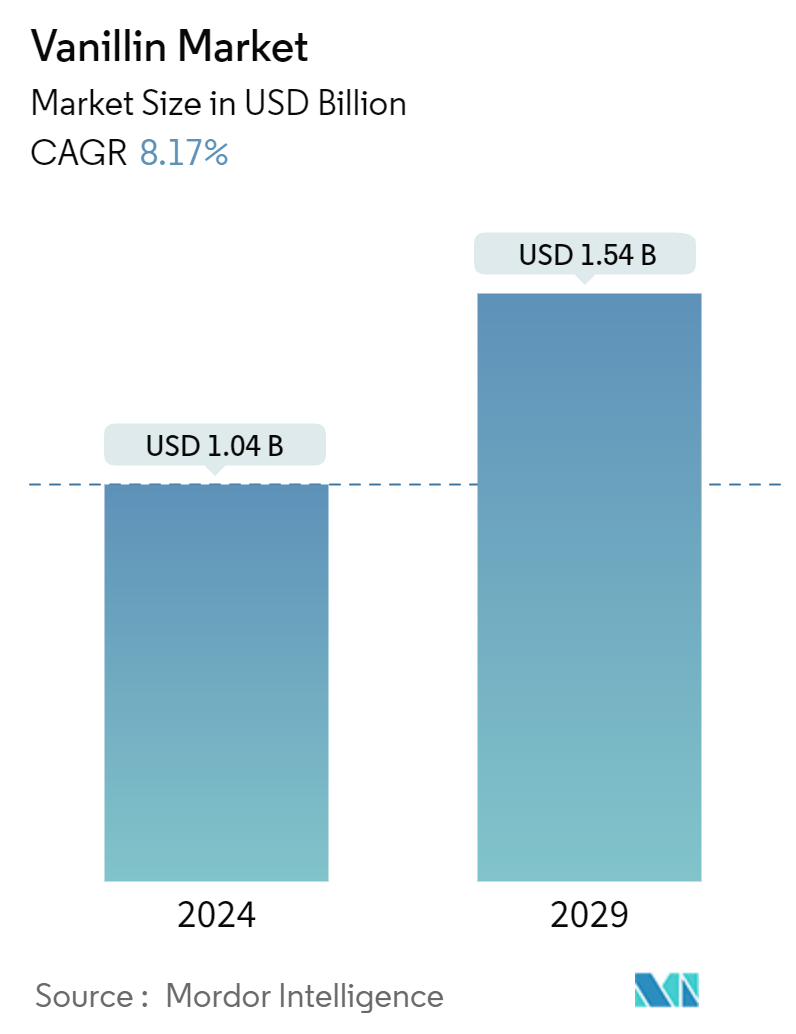Market Size of Vanillin Industry

| Study Period | 2019 - 2029 |
| Market Size (2024) | USD 1.04 Billion |
| Market Size (2029) | USD 1.54 Billion |
| CAGR (2024 - 2029) | 8.17 % |
| Fastest Growing Market | Asia-Pacific |
| Largest Market | Europe |
Major Players.webp)
*Disclaimer: Major Players sorted in no particular order |
Vanillin Market Analysis
The Vanillin Market size is estimated at USD 1.04 billion in 2024, and is expected to reach USD 1.54 billion by 2029, growing at a CAGR of 8.17% during the forecast period (2024-2029).
Natural vanillin obtained from vanilla seeds is limited in availability and usually very expensive. In recent years, the impact of global warming on the production of vanilla seeds has been felt very sharply due to frequent cyclones, the prevalence of higher-than-average temperatures, and rainfall. These climatic changes have negatively impacted the yield and production of vanilla seeds. Conversely, the utilization of synthetic vanillin has been on a steady rise, and it now dominates the market. Synthetic variants, being both cost-effective and functionally efficient, are increasingly favored across various applications. This shift has prompted companies to pivot toward vanillin derived from the fermentation or bioconversion of natural sources like rice bran, eugenol, and curcumin. For instance, in January 2023, Solvay introduced the first ISCC PLUS-certified mass balance vanillin. This launch directly responded to the heightened consumer and brand owner demands for sustainability and reduced carbon footprints.
Vanillin Industry Segmentation
Vanillin is a crystalline phenolic aldehyde produced synthetically or by extracting vanilla beans. It is used in diverse industries for its flavor and fragrance properties.
The global vanillin market is segmented by type, application, and geography. By type, the market is divided into natural and synthetic vanillin. The market studied is divided by application into food and beverage, pharmaceuticals, fragrances, and other applications. The report also analyzes the emerging and established geographical regions: North America, Europe, Asia-Pacific, and the Rest of the World.
The report offers market sizes and forecasts in value (USD) for the above segments.
| Type | |
| Natural Vanillin | |
| Synthetic Vanillin |
| Application | |
| Food and Beverage | |
| Pharmaceuticals | |
| Fragrances | |
| Other Applications |
| Geography | |||||||||
| |||||||||
| |||||||||
| |||||||||
| Rest of the World |
Vanillin Market Size Summary
The vanillin market is experiencing a significant transformation driven by evolving consumer preferences and environmental challenges. Natural vanillin, derived from vanilla seeds, is becoming increasingly scarce and expensive due to climate change impacts such as cyclones and temperature fluctuations. This scarcity has led to a rise in the use of synthetic vanillin, which is more cost-effective and functionally efficient, dominating the market. Companies are also exploring alternative sources of vanillin through bioconversion processes using natural materials like rice bran and eugenol to meet the growing demand for sustainable and ethically sourced ingredients. The introduction of ISCC PLUS-certified vanillin by Solvay highlights the industry's shift towards sustainability, responding to consumer and brand demands for reduced carbon footprints.
The global vanillin market is consolidated, with a few key players holding significant market shares. These companies, such as Solvay, Merck KGaA, and Borregaard AS, are expanding their production capacities and diversifying their product offerings to maintain a competitive edge. The European region, particularly Germany and Spain, is witnessing increased demand for vanillin due to the trend towards organic and sustainable products in the food, cosmetics, and pharmaceutical industries. The Spanish market, in particular, is growing due to the innovative use of vanilla in food and beverage products. As the market continues to evolve, the focus on sustainable and reliable vanillin sources is expected to drive further innovation and growth in the industry.
Vanillin Market Size - Table of Contents
-
1. MARKET DYNAMICS
-
1.1 Market Drivers
-
1.1.1 Innovation in Vanillin Synthesis
-
1.1.2 Diverse Functionality of Vanillin In End-use Industries
-
-
1.2 Market Restraints
-
1.2.1 Supply Chain Variability Impacting Vanilla Bean Availability For Flavor Production
-
-
1.3 Porter's Five Forces Analysis
-
1.3.1 Bargaining Power of Suppliers
-
1.3.2 Bargaining Power of Buyers
-
1.3.3 Threat of New Entrants
-
1.3.4 Threat of Subsitute Products and Services
-
1.3.5 Intensity of Competitive Rivalry
-
-
-
2. MARKET SEGMENTATION
-
2.1 Type
-
2.1.1 Natural Vanillin
-
2.1.2 Synthetic Vanillin
-
-
2.2 Application
-
2.2.1 Food and Beverage
-
2.2.2 Pharmaceuticals
-
2.2.3 Fragrances
-
2.2.4 Other Applications
-
-
2.3 Geography
-
2.3.1 North America
-
2.3.1.1 United States
-
2.3.1.2 Canada
-
2.3.1.3 Mexico
-
2.3.1.4 Rest of North America
-
-
2.3.2 Europe
-
2.3.2.1 Germany
-
2.3.2.2 United Kingdom
-
2.3.2.3 France
-
2.3.2.4 Russia
-
2.3.2.5 Spain
-
2.3.2.6 Italy
-
2.3.2.7 Rest of Europe
-
-
2.3.3 Asia-Pacific
-
2.3.3.1 China
-
2.3.3.2 India
-
2.3.3.3 Australia
-
2.3.3.4 Japan
-
2.3.3.5 Rest of Asia-Pacific
-
-
2.3.4 Rest of the World
-
-
Vanillin Market Size FAQs
How big is the Vanillin Market?
The Vanillin Market size is expected to reach USD 1.04 billion in 2024 and grow at a CAGR of 8.17% to reach USD 1.54 billion by 2029.
What is the current Vanillin Market size?
In 2024, the Vanillin Market size is expected to reach USD 1.04 billion.

